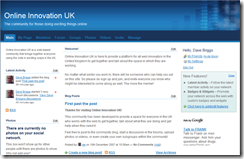 Twitter is becoming an indispensable tool for me – albeit one I didn’t know I needed until I started using it in a big way. I guess that as with a lot of these social networking type utilities, Metcalfe’s law applies – the more people use it, the more useful it is. Now I am following a number of people, and them tuning into my updates, suddenly I can’t get enough of pinging little messages around: about what I am doing, or what I need to know, or how I can help others.
Twitter is becoming an indispensable tool for me – albeit one I didn’t know I needed until I started using it in a big way. I guess that as with a lot of these social networking type utilities, Metcalfe’s law applies – the more people use it, the more useful it is. Now I am following a number of people, and them tuning into my updates, suddenly I can’t get enough of pinging little messages around: about what I am doing, or what I need to know, or how I can help others.
So what is Twitter? Well, it’s a ‘micro-blogging’ service. You’re limited to 160 characters per post. That limit is important, because it means you can use text messages from your mobile phone to update your status, and also to receive them from others.
As every good Web 2.0 service should, Twitter has released an API, meaning that others can building applications which ‘mashup’ Twitter with other services to make it more useful. A good example is Dave Winer‘s Twittergram, which lets you post short bursts of audio onto Twitter; or hashtags, which allows people to post on, and follow memes through Twitter.
Dan York has an excellent post on the ways he uses Twitter. I’ve quoted his headings below:
- Twitter as News Source
- Twitter as Knowledge Network
- Twitter as Virtual Water Cooler
- Twitter as a way to stay up-to-date with friends
- Twitter as a Travelogue
- Twitter to Track Conferences
- Twitter as a PR/marketing Tool
- Twitter as a Learning Tool
- Twitter as Fun
- Twitter as a Daily Lesson in Humility (and Brevity)
Today the service has had a little trouble though, and I blame Macworld. So many people will be sending Twitter updates from their mobile phones and laptops about the big breaking news from Steve Jobs’ keynote that the whole thing is under considerable strain. And Twitter isn’t the hardiest service at the best of times. More on this from Duncan Riley at Techcrunch. How hard would it be, I wonder, for some to just copy Twitter, but back it with sufficient infrastructure to actually work all the time?
Finally, a quick real world example of how Twitter can genuinely be helpful. Last week sometime, my good friend Steve Dale sent out a message requesting that someone suggest an example of a ‘shout box’ on a website. I responded within a few moments, giving a URL of a site where I had just added shoutbox functionality. Steve was in a meeting at the time, and those who were waiting for the shoutbox example were left open mouthed at the speed of this forum of communication and collaboration.
You can follow my latest Twitter updates in the widget on the left of this blog. Alternatively, join Twitter yourself and add me to your follow list!
 This blog has a clear theme this morning. Here’s another tool that makes Twitter even more useful: Twitter100. It displays the latest updates from up to 100 of the people you follow on one page. It certainly makes following what’s going on a lot easier.
This blog has a clear theme this morning. Here’s another tool that makes Twitter even more useful: Twitter100. It displays the latest updates from up to 100 of the people you follow on one page. It certainly makes following what’s going on a lot easier.
 Mike Butcher
Mike Butcher 
